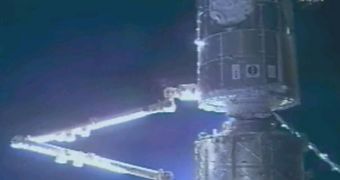As a result of the final connections being made to the European orbital laboratory Harmony, engineers from NASA tested this week the fluid connections, to make sure everything is in working order. And surprise-surprise, it wasn't! During a pressure test on the vestibule bridging between the International Space Station and the Harmony module, engineers detected a potential air leak, which lets air escape from the artificial atmosphere at a rate of 1.3 kilograms a day.
However, in a press conference yesterday NASA' spokesman said that this does not pose any concern, regarding the arrival of the space shuttle Atlantis on December 6, which is scheduled to deliver another European module, named Columbus. Engineers studying the problem pointed that the signal sent by the pressure detector is so weak, that they could not yet determine if the fissure is authentic or it is a parasite signal.
On the inspection made by the crew aboard the ISS with the ultrasound leak detector investigating the seal, they have reported that there is no sign of a leak. Furthermore, the artificial atmosphere does not present any evidence of decay or drop in overall pressure.
The test to ensure the proper connection of the Harmony module to the Destiny module detected the potential leak. A similar test was conducted soon after the docking of the module to the ISS, however the instruments used were less sensitive and only provided a 'gross' check, which detected no problems.
As a precaution measure, the engineers in charge with the inspection of the seal have scheduled another test today and maybe another in the days to come, to verify the connection. The Harmony module is especially important to the success of the ISS building schedule, as it is designed with multiple docking ports that will accommodate future modules.
The Harmony module has been flown to the ISS in the late October, and the crew completed its docking to the Destiny module, earlier this month, which involved three separate spacewalks in 15 days, to move the 16 ton bus-sized module in its final position.
Designed with multiple docking ports, the Harmony module will act as a bridge between the ISS and future European and Japanese modules, the first of them being the European Space Agency's Columbus module, that is scheduled to launch next week.
The mission will be carried out with the Atlantis space shuttle, with seven astronauts on board, one of them being intended to replace one of the crew members of the ISS. On Friday, the top shuttle officials will meet to set the exact date for the launch of 11-day mission.

 14 DAY TRIAL //
14 DAY TRIAL //